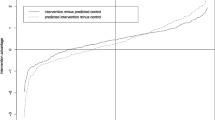Abstract
In prevention trials, outcomes of interest frequently include data that are best quantified as proportion scores. In some cases, however, proportion scores may violate the statistical assumptions underlying common analytic methods. In this paper, we provide guidelines for analyzing frequency and proportion data as primary outcomes. We describe standard methods including generalized linear regression models to compare mean proportion scores and examine tools for testing normality and other assumptions for each model. Recommendations are made for instances when the assumptions are not met, including transformations for proportion scores that are non-normal. We also discuss more sophisticated analytical tools to model change in proportion scores over time. The guidelines provide ready-to-use analytical strategies for frequency and proportion data that are commonly encountered in prevention science.





Similar content being viewed by others
References
Alnosaier, W. S. (2007). Kenward-Roger approximate F test for fixed effects in mixed linear models. (Doctoral dissertation). Retrieved from https://ir.library.oregonstate.edu/xmlui/handle/1957/5262.
Chamberlain, P., Price, J., Leve, L. D., Laurent, H., Landsverk, J. A., & Reid, J. B. (2008). Prevention of behavior problems for children in foster care: Outcomes and mediation effects. Prevention Science, 9, 17–27.
Cribari-Neto, F., & Zeileis, A. (2010). Beta regression in R. Journal of Statistical Software, 34, 1–23. doi:10.18637/jss.v034.i02.
Dobson, A. J. (2002). An introduction to generalized linear models (2nd ed.). London: Chapman and Hall.
Ferrari, S., & Cribari-Neto, F. (2004). Beta regression for modelling rates and proportions. Journal of Applied Statistics, 31, 799–815. doi:10.1080/0266476042000214501.
Gotelli, N. J., & Ellison, A. M. (2004). A primer of ecological statistics. Sunderland: Sinauer Associates.
Graham, J. W. (2009). Missing data analysis: Making it work in the real world. Annual Review of Psychology, 60, 549–576. doi:10.1146/annurev.psych.58.110405.085530.
Gregory, K. B. (2011). A comparison of denominator degrees of freedom approximation methods in the unbalanced two-way factorial mixed model. (Master’s thesis). Retrieved from http://www.learningace.com/doc/2798578/695791137a52ad51d325eaa95f220bd1.
Jiang, J. (2007). Linear and generalized linear mixed models and their applications. New York: Springer.
Kolko, D. J., Campo, J., Kilbourne, A. M., Hart, J., Sakolsky, D., & Wisniewski, S. (2014). Collaborative care outcomes for pediatric behavioral health problems: A cluster randomized trial. Pediatrics, 133, e981–e992. doi:10.1542/peds.2013-2516.
Lindhiem, O., Shaffer, A., & Kolko, D. J. (2014). Quantifying discipline practices using absolute vs. relative frequencies: Clinical and research implications for child welfare. Journal of Interpersonal Violence, 29, 66–81. doi:10.1177/0886260513504650.
Littell, R. C., Milliken, G. A., Stroup, W. W., Wolfinger, R. D., & Schabenberger, O. (2006). SAS for mixed models (2nd ed.). Cary: SAS Publishing.
Liu, S., Rovine, M. J., & Molenaar, P. C. M. (2012). Selecting a linear mixed model for longitudinal data: Repeated measures analysis of variance, covariance pattern model, and growth curve approaches. Psychological Methods, 17, 15–30. doi:10.1037/a0026971.
McCullagh, P., & Nelder, J. A. (1989). Generalized linear models (2nd ed.). London: Chapman and Hall.
Olsson, U. (2002). Generalized linear models: An applied approach. Lund: Studentlitteratur.
Pinheiro, J. C., & Bates, D. M. (2000). Mixed-effects models in S and S-PLUS. New York: Springer.
Raim, A. M., & Neerchal, N. K. (2013). Modeling overdispersion in binomial data with regression linked to a finite mixture probability of success. Proceedings of the Joint Statistical Meetings (ASA Section on Survey Research Methods) (pp. 2760–2774). Alexandria: American Statistical Association.
Schafer, J. L., & Graham, J. W. (2002). Missing data: Our view of the state of the art. Psychological Methods, 7, 147–77. doi:10.1037/1082-989X.7.2.147.
Schuhmann, E. M., Foote, R. C., Eyberg, S. M., Boggs, S. R., & Algina, J. (1998). Efficacy of parent–child interaction therapy: Interim report of a randomized trial with short-term maintenance. Journal of Clinical Child Psychology, 27, 34–45.
Shaffer, A., Lindhiem, O., & Kolko, D. J. (this issue). Treatment effects of a primary-care intervention on parenting behaviors: It’s all relative. Prevention Science.
Shelton, K. K., Frick, P. J., & Wootton, J. M. (1996). Assessment of parenting practices in families of elementary school-age children. Journal of Clinical Child Psychology, 25(3), 317–329.
Sokal, R. R., & Rohlf, F. J. (1995). Biometry: The principles and practice of statistics in biological research (3rd ed.). New York: W. H. Freeman.
Smithson, M., & Verkuilen, J. (2006). A better lemon squeezer? Maximum-likelihood regression with beta-distributed dependent variables. Psychological Methods, 11, 54–71. doi:10.1037/1082-989X.11.1.54.
Tabachnick, B. G., & Fidell, L. S. (2007). Experimental designs using ANOVA. Belmont: Duxbury.
Warton, D. I., & Hui, F. K. C. (2011). The arcsine is asinine: The analysis of proportions in ecology. Ecology, 92, 3–10. doi:10.1890/10-0340.1.
Wilson, K., & Hardy, I. C. W. (2002). Statistical analysis of sex ratios: An introduction. In I. C. W. Hardy (Ed.), Sex ratios: Concepts and research methods (pp. 48–92). New York: Cambridge University Press.
Zar, J. H. (1998). Biostatistical analysis (4th ed.). Englewood Cliffs: Prentice Hall.
This research was supported by a T32 Fellowship from the National Institute of Mental Health (NIMH) to the third author (T32MH018951) and by a grant from the NIMH to the fourth author (MH093508). The authors would also like to thank Dr. David Kolko for access to the SKIP2 (MH063272) dataset and Charles Bennett for the assistance with the manuscript preparation.
Author information
Authors and Affiliations
Corresponding author
Ethics declarations
Funding
This research was supported by grants from the National Institute of Mental Health (MH093508; MH063272; MH018951).
Conflict of Interest
The authors declare that they have no conflict of interest.
Ethical Approval
All data collection procedures were carried out with approval from, and in compliance with, the IRB at the University of Pittsburgh.
Informed Consent
Informed consent was obtained from all individual participants included in the study.
Rights and permissions
About this article
Cite this article
Chen, K., Cheng, Y., Berkout, O. et al. Analyzing Proportion Scores as Outcomes for Prevention Trials: a Statistical Primer. Prev Sci 18, 312–321 (2017). https://doi.org/10.1007/s11121-016-0643-6
Published:
Issue Date:
DOI: https://doi.org/10.1007/s11121-016-0643-6




